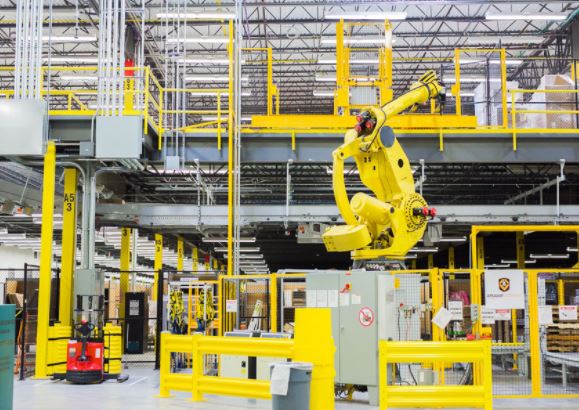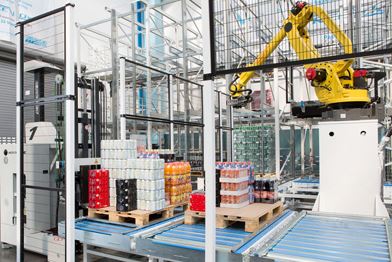Robots are emerging in distribution centers (DCs) throughout the country at increasing levels. You’ll find them at the end of production lines stacking cases on pallets or at the induction of a line unstacking cases onto conveyor lines. Wherever there is a repetitive task, there is an opportunity to automate, and the large DCs are taking advantage of all that robots offer.
find them at the end of production lines stacking cases on pallets or at the induction of a line unstacking cases onto conveyor lines. Wherever there is a repetitive task, there is an opportunity to automate, and the large DCs are taking advantage of all that robots offer.
Manufacturing has been in this environment for years, but robots are now playing a more prominent role as the crisis in finding reliable labor only gets worse.
Automated solutions throughout the entire production line
A few examples of robotic tasks that might not come to mind include the following:
- Mixed SKU cases on a conveyor line — An operator twists and bends to stack cases on individual pallets to be put away. First, the physical demands the operator endures to do this task is exhausting plus increases the risk of work-related injuries. Secondly, order accuracy will improve as the robot reads a barcode and puts the case in the appropriate position. Lastly, production rates will increase as the robot will do this task at the same speed for as long as the job requires — without taking breaks.
- Large bins of product stored in a racking system as a buffer for the progressive
 production lines — A forklift operator puts away a completed bin until it’s needed again. Now, imagine a robot running on a rail mounted to the floor, moving these bins to each work cell when needed, using the racking system as a buffer. That leads to increased productivity and there’s no need to wait for an operator as one is not required.
production lines — A forklift operator puts away a completed bin until it’s needed again. Now, imagine a robot running on a rail mounted to the floor, moving these bins to each work cell when needed, using the racking system as a buffer. That leads to increased productivity and there’s no need to wait for an operator as one is not required. - A robot picks individual items off a rack or shelving and brings it to a packing station — You can focus on a specific task while letting the robot do the running around.
- A robot on an automated order picker — Stay tuned as this is not as farfetched as it may sound. Technology is advancing to the point where we’ll see orders come in and robots handle the picking process from start to finish.
- Pick carts filled with totes — The carts can be brought to specific locations and a robot can remove the totes and place them on a conveyor line. This allows you to pick new carts while the robot does the repetitive task of emptying the carts.
These are just a few scenarios, but I bet if you spent an hour walking around your facility, you would come up with many possibilities to integrate automation.
Evaluating your warehouse operations
In previous years, the cost of a robot was a deterrent. However, as with all products, the volume reduces cost and makes what was once a pipe dream a reality. With an increasing demand for quicker turnaround time, the push for overall cost reduction, the unavailability of labor and the decreasing price of robotics, now is the perfect time to consider this wildly popular alternative.
So, if you see any opportunities where automation and robotics could make sense in your operations, contact the material handling specialists at Abel Womack. We would be glad to discuss options to help you increase productivity, reduce your required labor, and improve overall profitability and performance.

 production lines — A forklift operator puts away a completed bin until it’s needed again. Now, imagine a robot running on a rail mounted to the floor, moving these bins to each work cell when needed, using the racking system as a buffer. That leads to increased productivity and there’s no need to wait for an operator as one is not required.
production lines — A forklift operator puts away a completed bin until it’s needed again. Now, imagine a robot running on a rail mounted to the floor, moving these bins to each work cell when needed, using the racking system as a buffer. That leads to increased productivity and there’s no need to wait for an operator as one is not required.

Leave a Reply
You must be logged in to post a comment.